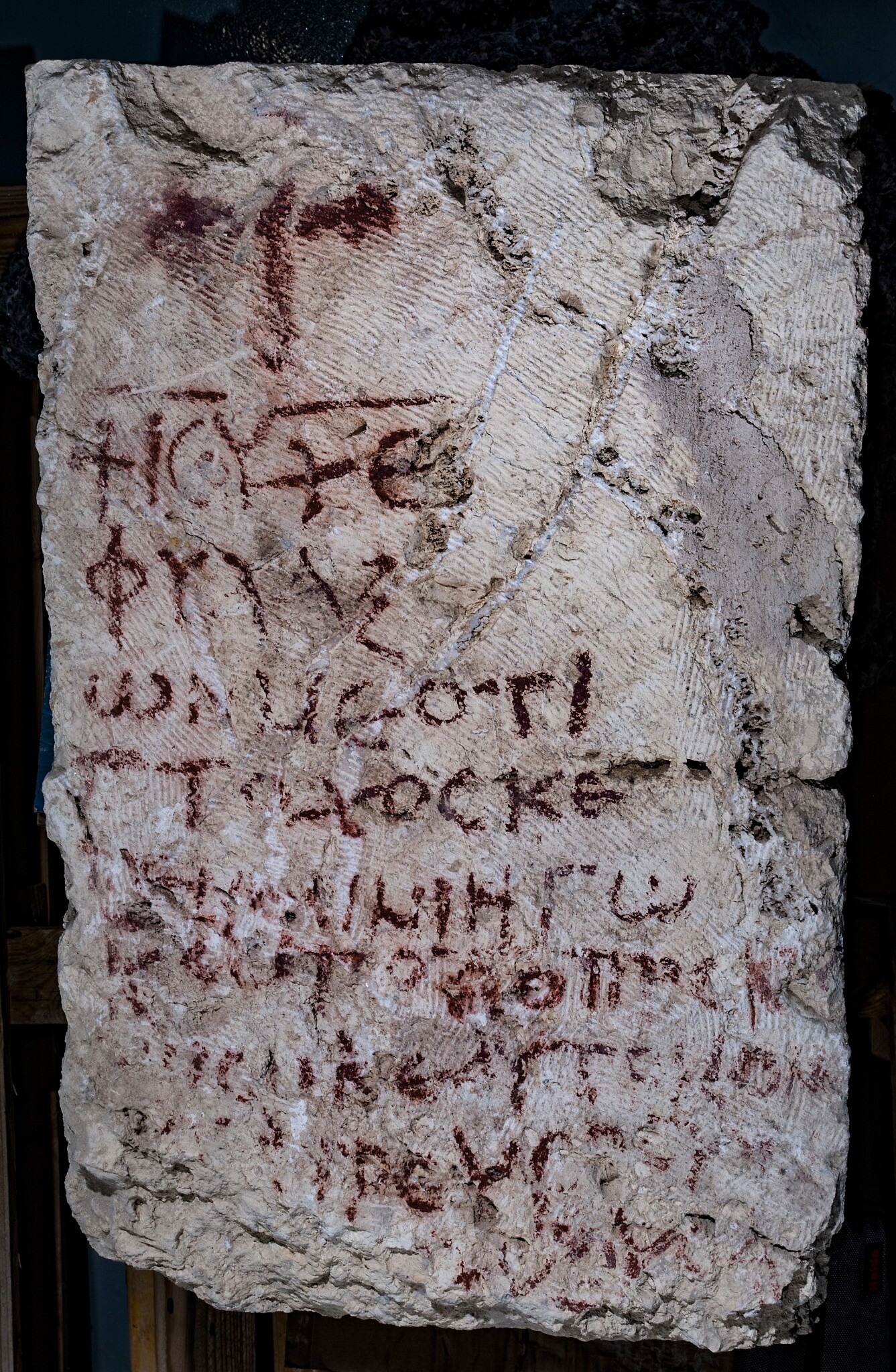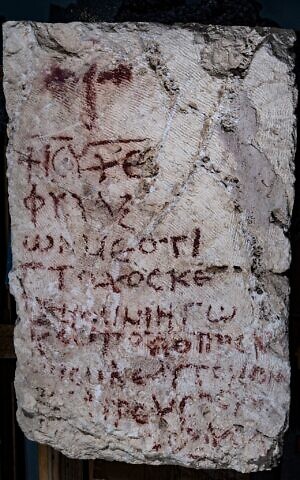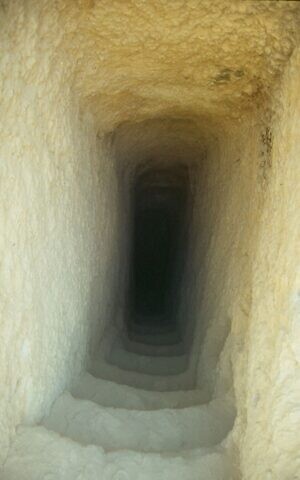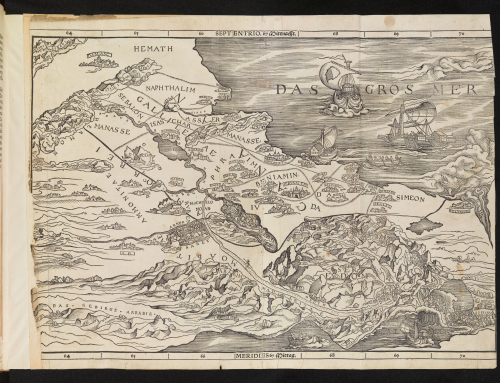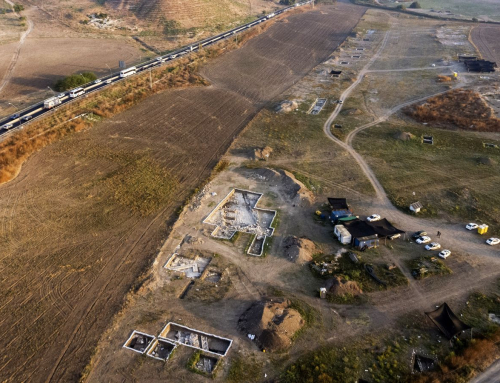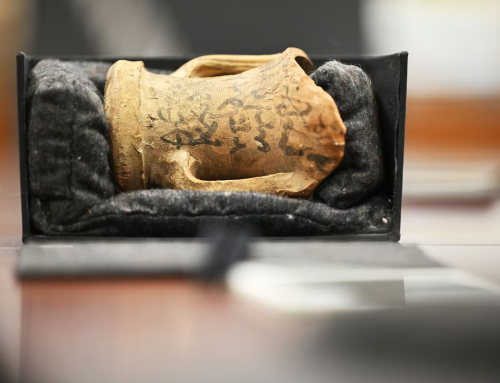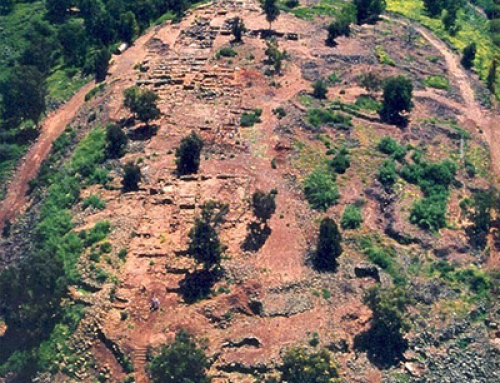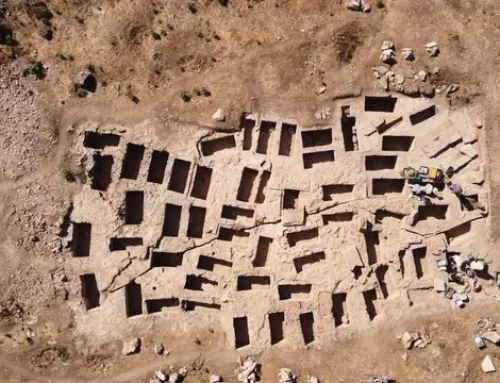A rare inscription paraphrasing part of Psalm 86 in the Greek used in the New Testament has been unearthed by a team of Hebrew University archaeologists working at the Hyrcania Fortress, a Second Temple-era structure situated atop a forbidding hilltop in the Judean Desert, about 17 kilometers southeast of Jerusalem.
Found painted in red, under a cross, on the side of a large building stone, the Koine Greek inscription reads: “Jesus Christ, guard me, for I am poor and needy. Guard my life, for I am faithful to you.” In the original Hebrew psalm, known as “A Prayer of David,” the first section reads, “Hear me, Lord, and answer me.”
A community of Byzantine Christian monks founded in the 5th century CE is likely responsible for the adapted Psalm 86 inscription. Dr. Avner Ecker of Bar-Ilan University, who helped decipher the inscription, noted that the writing contains small grammatical errors, indicating that “the priest was not a native Greek speaker, but likely someone from the region who was raised speaking a Semitic language.”
The 2023 Hyrcania excavation was directed by Dr. Oren Gutfeld and Michal Haber of the Hebrew University, in conjunction with Carson-Newman University (Tennessee) and American Veterans Archaeological Recovery, a program that uses archaeology to help US armed forces veterans transition back to civilian life.
In addition to the psalm adaptation, a similar inscription was found nearby, which is still awaiting analysis. These are probably the only Koine Greek Psalm inscriptions ever found on stone, as opposed to on parchment or other materials, the archaeologists noted.
The pilot dig, which took place earlier this year, was the first “methodological, academic archaeological excavation” undertaken at the site, the university said. Previously, the site had a few short visits by European archaeologists, the last of note being in the 1950s when a Belgian archaeologist, after being led to the site by Bedouins, discovered a trove of papyrus documents. The area was controlled by Jordan at the time.
The Hyrcania Fortress dates from the Hasmonean dynasty (2nd to 1st centuries BCE) and sits atop a 200-meter hill that was flattened to accommodate the buildings, part of a series of hilltop desert fortresses. Later, King Herod greatly expanded and refurbished the fortress, as he did with the more well-known Masada and Herodium sites.
After Herod’s death in 4 BCE, Hyrcania fell into disuse, until the small Byzantine Christian monastery was founded there at the end of the 5th century CE. This monastery, called Kastellion or “Little Castle” in Greek, survived the later Islamic conquest of the area around 635 CE and was in use until the early 9th century.
Since then the site has been abandoned and lies largely in ruins, with crumbling monastery buildings lying atop the ancient Herodian and Hasmonean structures.
Also found on the dig was a small gold ring, around 1 centimeter in diameter, bearing a turquoise stone with an Arabic inscription “Mashallah” (God has willed it). Based on the script, the ring was dated to the Umayyad caliphate (7th to 8th centuries CE), after the Islamic conquest of the area, and might have been used as a seal. The turquoise itself likely hailed from Persia.
An ‘Indiana Jones’ moment
Gutfeld, one of the lead archaeologists, has a long history at the site. Back in 2000, in an “Indiana Jones moment,” he began exploring two “enigmatic tunnels” found at the base of the hill, he told The Times of Israel. These “completely man-made,” stepped tunnels slope downwards to a depth of 120 and 80 meters but both then reach a dead end.
They were first discovered by a British scholar in 1960, but he wasn’t able to excavate them and was forced to stop his explorations because of weather conditions, Gutfeld said. His own efforts over several years, after 2000, yielded some small First Temple-era artifacts, but how and why the tunnels were built remains uncertain.
Michal Haber, the other Hebrew University archaeologist leading the dig, noted that King Herod is known to have imprisoned his enemies, “real or imaginary,” in Hyrcania. One of the theories is that the tunnels were a “slave labor” project that was unfinished, or undertaken as a form of Sisyphean punishment to keep the prisoners busy, she said.
Gutfeld “returned around 2015, 2016” for further exploration and found the site on top of the hill “pristine.” It was this visit that prompted the current organized explorations, which he said would not have been possible in earlier years due to logistical issues associated with the remoteness of the site, which is located in the West Bank. Another excavation, to last about four weeks, is planned for early 2024.
The site also contains Herodian and Byzantine graves, but those were “systematically looted long ago,” Gurfeld explained. However, most of the fortress, largely in ruins, remains fairly untouched. The inaccessibility and dismal climate of Hyrcania – it is in the deep desert with no nearby water – have likely helped keep most looters at bay.
The Israeli Antiquities Authority, in conjunction with the Civil Administration of Judea and Samaria, has in recent years launched an ambitious project to map, explore and secure the myriad archaeological sites strewn about the Judean Desert. The Hyrcania Fortress falls under this aegis.
“We are aware that our excavations will draw the attention of looters. The problem persists; it was here before us and will likely continue after us, underscoring the need for academic excavation – particularly in such a sensitive site as Hyrcania, though this is just one example. We are simply trying to stay a few steps ahead,” Haber and Gutfield said in a statement.
Original Article – Unique Byzantine Psalm inscription in New Testament Greek discovered in Judean Desert | The Times of Israel

